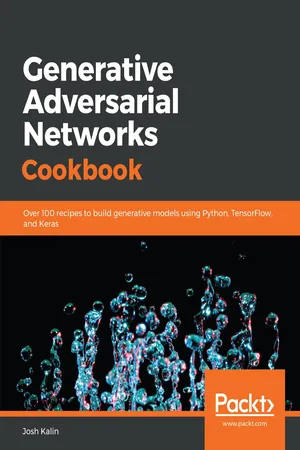
Generative Adversarial Networks Cookbook
Over 100 recipes to build generative models using Python, TensorFlow, and Keras
Josh Kalin
- 268 pages
- English
- ePUB (mobile friendly)
- Available on iOS & Android
Generative Adversarial Networks Cookbook
Over 100 recipes to build generative models using Python, TensorFlow, and Keras
Josh Kalin
About This Book
Simplify next-generation deep learning by implementing powerful generative models using Python, TensorFlow and Keras
Key Features
- Understand the common architecture of different types of GANs
- Train, optimize, and deploy GAN applications using TensorFlow and Keras
- Build generative models with real-world data sets, including 2D and 3D data
Book Description
Developing Generative Adversarial Networks (GANs) is a complex task, and it is often hard to find code that is easy to understand.
This book leads you through eight different examples of modern GAN implementations, including CycleGAN, simGAN, DCGAN, and 2D image to 3D model generation. Each chapter contains useful recipes to build on a common architecture in Python, TensorFlow and Keras to explore increasingly difficult GAN architectures in an easy-to-read format. The book starts by covering the different types of GAN architecture to help you understand how the model works. This book also contains intuitive recipes to help you work with use cases involving DCGAN, Pix2Pix, and so on. To understand these complex applications, you will take different real-world data sets and put them to use.
By the end of this book, you will be equipped to deal with the challenges and issues that you may face while working with GAN models, thanks to easy-to-follow code solutions that you can implement right away.
What you will learn
- Structure a GAN architecture in pseudocode
- Understand the common architecture for each of the GAN models you will build
- Implement different GAN architectures in TensorFlow and Keras
- Use different datasets to enable neural network functionality in GAN models
- Combine different GAN models and learn how to fine-tune them
- Produce a model that can take 2D images and produce 3D models
- Develop a GAN to do style transfer with Pix2Pix
Who this book is for
This book is for data scientists, machine learning developers, and deep learning practitioners looking for a quick reference to tackle challenges and tasks in the GAN domain. Familiarity with machine learning concepts and working knowledge of Python programming language will help you get the most out of the book.
Frequently asked questions
Information
Data First, Easy Environment, and Data Prep
- Is data that important?
- But first, set up your development environment
- Data types
- Data preprocessing
- Anomalous data
- Balancing data
- Data augmentation
Introduction
Is data that important?
Getting ready
How to do it...
- Data preprocessing
- Balancing data
- Anomalous data
- Data augmentation
- Read in data as a NumPy array
- Check the distribution of the data for anomalous indices
- Balance the dataset for the learning step
- Throw out the anomalous data
- Augment our data in an structured and intelligent manner
How it works...
There's more...
- Python: https://wiki.python.org/moin/BeginnersGuide/Overview
- NumPy: https://docs.scipy.org/doc/numpy/
- SciPy: https://www.scipy.org/getting-started.html
But first, set up your development environment
Getting ready
- GPU: 10 series CUDA-enabled Nidea GPU
- Operating system: Ubuntu Linux 16.04+
- CPU/RAM: i5 or i7 with at least 8 GB of RAM